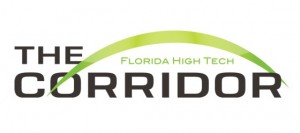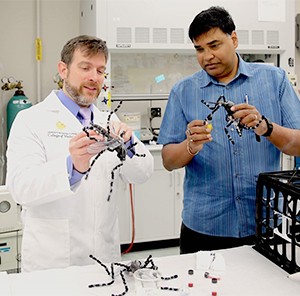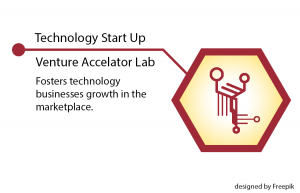Startups, Start Here: Top Two Matching Grant Funds in Florida for Tech Companies Partnered with UCF
April 27, 2016
It takes capital to launch a company. If your startup’s product or service is powered by technology developed at a public university in Florida, you may be eligible for matching grants. As discussed in the last Startups, Start Here blog post, the Venture Accelerator Lab (VAL) at UCF can help you identify grants, including matching grants, to raise capital.
As their name suggests, matching grants require companies to secure another source of funding, and will typically match it at a 1:1 or a 2:1 ratio. The benefits for obtaining such monies are manifold:
- The funds do not dilute investment equity.
- Startup costs are shared with other funders.
- Funders who may be tentative are incentivized by the shared risk.
- The additional funds, and the source of the funds, build credibility for your business.
- Through partnering with the funding organization, your startup gains publicity.
Two local resources within the Florida entrepreneurial ecosystem, the Florida High Tech Corridor Council (FLHTCC) and the Florida Institute for the Commercialization of Public Research (FICPR) provide matching grant funds for startup companies commercializing university research.
Florida High Tech Corridor Council
 The Florida High Tech Corridor Council was founded in 1996 to support a 21-county service area for both UCF and the University of South Florida (USF) in Tampa. In 1997, it expanded to 23 counties across Central Florida and included the University of Florida (UF).
The Florida High Tech Corridor Council was founded in 1996 to support a 21-county service area for both UCF and the University of South Florida (USF) in Tampa. In 1997, it expanded to 23 counties across Central Florida and included the University of Florida (UF).
The mission of The Corridor is “to grow high-tech industry and innovation through partnerships that support research, marketing, workforce, and entrepreneurship.” The Corridor provides a link between UCF, USF, and UF and their industry partners by supporting applied research.
Specifically, matching funds are available for companies commercializing research from one of ten key high-tech industries targeted for growth:
| Argritechnology | Life Sciences/Medical Technologies |
| Aviation and Aerospace | Microelectronics/Nanotechnology |
| Digital Media/Interactive Entertainment | Modeling, Simulation, and Training |
| Financial Services | Optics and Photonics |
| Information Technology | Sustainable Energy |
If your startup company falls into any of these ten categories, there are two ways to receive funds from The Corridor’s Matching Grants Research Program:
- The Open Call requires that a corporation must match funds up to $3 for every Corridor dollar granted. Awards range from $10,000 to $150,000.
- The SBIR/STTR Phase II Industry External Investment Program provides matching funds to those businesses who have already procured government funding from SBIR (Small Business Innovation Research) or STTR (Small Business Technology Transfer) programs.
For either of these funding programs, a startup company must be linked to UCF, USF, or UF. To learn more about these opportunities, visit the FLHTCC site.
Florida Institute for the Commercialization of Public Research
 The Florida Institute for the Commercialization of Public Research (FICPR), a partnership with state universities and research institutions, was formed in 2007, and its mission is to support “economic development through the commercialization of new discoveries generated from publicly funded research.”
The Florida Institute for the Commercialization of Public Research (FICPR), a partnership with state universities and research institutions, was formed in 2007, and its mission is to support “economic development through the commercialization of new discoveries generated from publicly funded research.”
The Institute’s Company Funding program provides $50,000 – $300,000 in seed funding, which may be provided as either debt or equity, to qualified companies. Funding is provided by the State of Florida through the Department of Economic Opportunity.
To see if your company qualifies for funding and to apply visit the FICPR site.
—
If you are commercializing UCF technology, you may qualify for these matching grants. We can help identify the best tech solutions to meet your company’s goals.
The Buzz on Tracking Disease-Carrying Mosquitoes
April 7, 2016
There’s one tiny pest that bugs Americans as the temperatures heat up: mosquitoes. Besides causing itchy welts and bumps, mosquitoes can carry a multitude of diseases including West Nile virus, chikungunya, malaria, dengue fever, many types of encephalitis, and yellow fever. Additionally, with the modern convenience of international travel, diseases that are usually geographically isolated are more prone to wide-spread outbreaks, such as the most recent epidemic of the Zika virus.
Recently, the Center for Disease Control stated that the two particular mosquito species that are known to carry Zika, aedes aegypti (the yellow fever mosquito) and aedes albopictus (the Asian tiger mosquito), may be inhabiting places further north and west than just the southern region of the United States. As the spring and summer seasons progress, the Zika virus can potentially spread throughout the country, although not nearly as rapidly as it has in Latin America and the Caribbean.
The reason for the limited mosquito-borne disease outbreaks in the U.S. is that, in comparison, the developing world lacks the barriers that are standard in the developed world (e.g., air conditioners and window screens), making disease outbreaks much harder to control.
An additional burden to effective mosquito control is the currently available surveillance methods. They involve traps requiring electrical power and, in order to determine concentration levels of a particular disease, insect specimens must be sent out to a lab for analysis. Most communities in the developing world cannot sustain these requirements.
In response to the need for simpler, more manageable surveillance strategies, Bradley Willenberg, Ph.D., assistant scientist in the College of Medicine and profiled in our Faculty Feature this month, has helped to create a passive (i.e., requiring no electricity) mosquito surveillance system that virtually anyone, anywhere can use. It can be used wherever mosquito monitoring is needed, even in the more remote areas of the world.
The trap works by luring the mosquitoes with a scented mixture specifically created for the aedes aegypti and aedes albopictus species. Once inside, the mosquitoes find a wick-based device, soaked in a cocktail of red-dyed sugar water, insecticide, and gold nanoparticles—technology created by materials scientist Sudipta Seal, Ph.D. and his team.
Once the insect ingests the solution, specially formulated nanoparticles bind to the proteins of the monitored disease, causing the mosquito’s full belly to turn from red (as a result of the dyed sugar water) to blue. Thus, the greater number of dead blue mosquitoes, the greater the concentration of disease-carrying insects. For each disease, a special gold nanoparticle can be created, which involves a vast amount of research. For example, the Zika virus and dengue fever are similar in their genetic makeup so one of the research challenges is to identify the differences.
The research behind this innovation has received some notable funding support for global ventures as well as some local partnership opportunities. This mosquito surveillance project received a $100,000 Phase 1 Grand Challenges Explorations Grant from the Bill & Melinda Gates Foundation in November 2015, focusing on monitoring chikungunya. Willenberg is also working with the state of Florida to develop a sensor to detect salivary proteins in mosquitoes for further research on the insect.
—
A low-tech mosquito surveillance system that only requires the ability to see changing colors has the potential to create a healthier world and is currently being developed here at UCF. To learn more, contact Brion Berman.
Photo courtesy of UCF College of Medicine
Startups, Start Here: Need Help Getting a Commercialization Grant?
Working on fundamental research with potential commercial impact? Need assistance identifying commercialization grants to fund your research or new venture? At the Venture Acceleration Lab (VAL), we assist faculty, postdocs, graduate and undergraduate students, and entrepreneurs with the identification and pursuit of funding opportunities from federal and other government agencies. This includes grants from SBIR / STTR, ARPA-E, the NSF Partnership for Innovation programs: ‘Accelerating Innovation Research-Technology Transfer’ and ‘Building Innovation Capacity,’ and more. We provide hands-on assistance ranging from identifying funding opportunities and solicitation requirements to effective writing and submitting of competitive proposals.
Using the seven steps below, we can assist you with developing a competitive funding proposal:
- Finding the appropriate funding opportunity (grant proposal)
It is important to identify a grant opportunity that is related to your research. The proposed idea should support the program’s solicitation and interests. - Providing a proposal template
Government agencies regularly update their solicitation and proposal requirements and it is imperative that you follow them exactly to be considered for funding. At VAL, we provide up-to-date proposal templates to ensure your submission meets the solicitation’s formatting and commercialization strategy requirements. - Developing a commercialization strategy
As you might expect, a research commercialization section is included in all commercialization grants and, as in the case of Phase II grants, it can be as lengthy as 15 pages. This requires thorough development of the strategy by working with seasoned entrepreneurs and industry professionals in the subject area. - Researching the market and the competitive landscape
A couple of key points to consider while developing a commercialization grant application are to address the market need and highlight the uniqueness of the proposed innovation by providing a competitive landscape. This establishes an urgency to bring the innovation to market and a justification for the requested funds. - Introducing you to strategic partners
It is essential to connect with industry leaders and strategic partners to map out a successful commercialization path. Letters of support obtained from these leaders and partners can increase the credibility of the proposed innovation. - Reviewing your proposal
Before the final submission, we do an in-depth review of your proposal to provide edits, comments, and additional content. - Assisting with follow-up support
After the proposal submission, we support you with implementing the commercialization strategy and introducing you to and preparing you for private funding opportunities.
We can assist you with all of the aforementioned steps as well as any areas that may be specific to you. If you are planning to pursue a grant, we recommend contacting us at least two months in advance of the submission deadline so we can start developing a commercialization strategy and identifying and connecting with strategic partners. However, we can assist you in whatever stage of the proposal writing process you are in.
—
To learn more about commercialization grants and the variety of funding resources available to you for your research or your new venture, contact Jack Henkel at the Venture Acceleration Lab.

